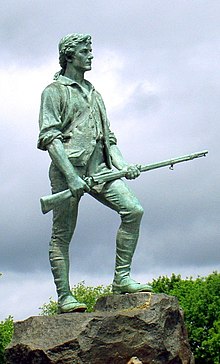Minutemen (militia)
The Minutemen ( Minute Men ) were a militia in the British colonies in North America that should be ready to fight within a minute of being asked. Not every member of the militia was a minuteman, but especially motivated, daring young men under 25 were grouped into minutemen units.
The term minutemen was also given to various later US military units to commemorate the success and patriotism of their predecessors in the War of Independence . Later one was ICBM as a Minuteman named, and a rock band chose Minutemen as names.
history
As early as the time of the Massachusetts Bay Colony in 1645, some men were selected from the various local militias for their rapid deployment. The militia in this province in particular had already been used in many conflicts, such as the King Philip's War , the French and Indian War and finally the War of Independence in the battles of Lexington and Concord . Every generation of New England settlers was familiar with such combat operations, every place had a militia, and every man between the ages of 16 and 60 was required to serve in the militia. However, there were many exceptions here, for example for certain professional groups. Service in the militia was initially regulated in so-called Militia Acts and, after the outbreak of the War of Independence, in Militia Bills. Many of these men were farmers and mostly related to one another, so it was customary to fight alongside one's cousins and brothers-in-law.
Some places in Massachusetts traditionally assigned some of their militiamen to the Minutemen units, while others preferred to keep their entire militia in a closed unit. After an unpopular measure on the part of the British government in the fall of 1774, the Powder Alarm , in which black powder was to be confiscated, the newly formed Provincial Congress of Massachusetts decided that all militias should form special Minutemen units. They should receive in-depth combat training and be ready to fight quickly, if possible within one minute of receiving the message. This decision was implemented in some places and not in others.
The Minutemen were usually under 25 years of age and were chosen if they had the motivation, reliability and strength to do so. They should be the first armed units to enter combat. The officers were chosen from within their own ranks. When it was set up, each unit gave itself a statute, compliance with which the recruits had to confirm with their signature when they were accepted. They usually met four times a year for training in peacetime. Even in combat, it was customary for officers to discuss how to proceed with their men before giving their orders.
The stories about the Battle of Lexington and Concord in 1775, the first battle of the War of Independence, often count the militia on the American side among the Minutemen, especially the militia of Captain John Parker from Lexington . In the battle, however, the Lexington militias were combined into a unit that traditionally called itself a town training band .
Other colonies facing the same challenges had set up similar minute companies . Over time, the term minutemen became a synonym for all US militias.
Equipment, training and tactics
Most of the militia units were armed by the government but not with uniforms. Many therefore wore their normal work clothes. The main weapon was the musket , but it was not accurate at distances of more than 65 meters. The military version of the musket also had a bayonet .
The members of the later Continental Army received military training geared towards Europe, and the militias were included here, if possible. The militias were mainly used as skirmishers and light infantry . In addition, parts of the militias from the Indian and French wars were experienced in the tactics of guerrilla warfare.
The Minutemen were neither settlers nor wilderness dwellers who had to fight for their lives every day. The typical militiaman was almost always a farmer and came from a civilized, strictly regulated society. The militias and minutemen were trained in the tactics customary at the time. For example, Massachusetts used the same training regime as the British Professional Army.
Aftermath
At the centenary commemorating the first successful armed resistance against the British troops, the young sculptor Daniel Chester French from Concord created the Concord Minuteman as his first major commission . On the base there is an inscription with the opening stanza of Ralph Waldo Emerson's Concord hymn from 1837 with the words: “ ... Shot heard round the world. “(The shot heard all over the world). French said that the statue should represent the "Minute Man".
literature
- David Hackett Fischer: Paul Revere's Ride , New York [u. a.] 1994, ISBN 0-19-508847-6 .
- Robert A. Gross: The Minutemen and Their World , New York 1976, ISBN 0-8090-0120-9 .
- The Encyclopedia of Military History, from 3500 BC to the Present , ed. by R. Ernest Dupuy and Trevor N. Dupuy , ISBN 0-06-270056-1 .
- The underlying article in the English Wikipedia contains material from the Encyclopædia Britannica from 1911, which is in the public domain.

